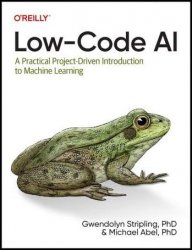 Название: Low-Code AI: A Practical Project-Driven Introduction to Machine Learning (Final)
Название: Low-Code AI: A Practical Project-Driven Introduction to Machine Learning (Final)Автор: Gwendolyn Stripling, Michael Abel
Издательство: O’Reilly Media, Inc.
Год: 2023
Страниц: 325
Язык: английский
Формат: True EPUB (Retail Copy)
Размер: 14.9 MB
Take a data-first and use-case–driven approach with Low-Code AI to understand Machine Learning and Deep Learning concepts. This hands-on guide presents three problem-focused ways to learn no-code ML using AutoML, low-code using BigQuery ML, and custom code using scikit-learn and Keras. In each case, you'll learn key ML concepts by using real-world datasets with realistic problems.
Business and data analysts get a project-based introduction to ML/AI using a detailed, data-driven approach: loading and analyzing data; feeding data into an ML model; building, training, and testing; and deploying the model into production. Authors Michael Abel and Gwendolyn Stripling show you how to build machine learning models for retail, healthcare, financial services, energy, and telecommunications.
Artificial Intelligence (AI) can be defined as the broad field of study where computers show intelligence. The phrase “show intelligence” is vague; it could be interpreted as a computer making a decision that we would expect from a living being. In recent decades, another form of AI has become more ubiquitous. Machine learning (ML) is the discipline of having computers learn algorithms from the data provided rather than the programmer having to provide the algorithms. Another way to phrase this in contrast to expert systems is that ML is about using data to discover the rules versus having experts write the rules for you.
ML touches almost every industry nowadays. In retail, ML is used for demand forecasting, predicting the expected sales of products or services months in advance. The travel industry uses ML to recommend points of interest and destinations to customers based on their past travel history and other information. In healthcare, ML can be used to not only determine if an X-ray image contains a healthy or diseased lung, but it can also pinpoint the region of the X-ray image that led to the determination for medical experts to explore in more detail. The list of active uses of ML could fill up an entire book on its own. In this book we focus on a few specific ML use cases to get you started, including advertising media channel sales, energy production, and customer churn just to name a few.
You'll learn how to:
• Distinguish between structured and unstructured data and the challenges they present
• Visualize and analyze data
• Preprocess data for input into a machine learning model
• Differentiate between the regression and classification supervised learning models
• Compare different ML model types and architectures, from no code to low code to custom training
• Design, implement, and tune ML models
• Export data to a GitHub repository for data management and governance
Who Should Read This Book?
The goal of this book is to teach readers how to frame ML problems for structured (tabular) data, prepare their data for ML workflows, and build and use ML models using different no-code, low-code, and some basic custom code solutions. You will go through step-by-step processes to understand these objectives within the framing of a specific business problem. The primary audience for this book are business analysts, data analysts, students, and aspiring citizen data scientists who seek to learn how to apply ML to their work very quickly using automated machine learning (AutoML), BigQuery ML (using SQL), and custom training in Python. Some basic familiarity with data analysis is assumed, but you don’t need to be an expert to benefit from going through this book.
Anyone considering a career move into data science and/or ML engineering may also find this book to be a great first step toward their goal. ML practitioners will likely find this book to be too basic for their needs, but they may find discussions on some of the tools being used to be helpful if they are unfamiliar. No prior knowledge of ML or a specific programming language is required, but readers will find the book a little easier to read with some basic knowledge of programming concepts, Python, and SQL. We include references to additional foundational material within context throughout the book. In addition to ML concepts and use case–based examples, you will also explore different tools such as Jupyter Notebooks and basic use of the Linux terminal.
Скачать Low-Code AI: A Practical Project-Driven Introduction to Machine Learning (Final)